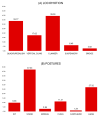Locomotion, Postures, and Substrate Use in Captive Southern Pygmy Slow Lorises (Strepsirrhini, Primates): Implications for Conservation
- PMID: 40509042
- PMCID: PMC12153727
- DOI: 10.3390/ani15111576
Locomotion, Postures, and Substrate Use in Captive Southern Pygmy Slow Lorises (Strepsirrhini, Primates): Implications for Conservation
Abstract
Studies of positional (=locomotor and postural) behavior are central to understanding how animals interact with the challenges imposed by their environment and are crucial for conservation management. The present study investigates, for the first time, the positional behavior and substrate use of the endangered southern pygmy slow loris Xanthonycticebus pygmaeus. Despite their very specialized morphology and ecology, the positional behavior of lorises is understudied. Behavioral data were collected using 30-s scan instant sampling on seven captive animals housed in a large, enriched enclosure of the Poznań Nowe Zoo (Poland) during February-June 2013. Pygmy slow lorises were almost exclusively arboreal and most activities occurred on multiple substrates (82.93%). Small (57.91%) and large (28.28%) substrates were extensively used. Horizontal (42.11%) and oblique (38.47%) substrates dominated. Clamber (39.39%), quadrupedalism (33.77%), and vertical climb (17.62%) were the main locomotor modes. Standing was the dominant posture (47.23%), followed by hanging (27.32%) and clinging (11.31%). Our results concur with the limited observations available on other lorisines; pygmy slow lorises employed a diverse and flexible positional repertoire as an adaptation to the exploitation of the continuous forest layers with intertwined small substrates of various inclinations. Consequently, protecting and managing these habitats, supported by ex situ reintroduction programs, can effectively contribute to the conservation of the species' populations.
Keywords: Xanthonycticebus pygmaeus; canopy; forest; positional behavior; small branches.
Conflict of interest statement
The authors declare no conflicts of interest. The funders had no role in the design of the study; in the collection, analyses, or interpretation of data; in the writing of the manuscript; or in the decision to publish the results.
Figures
Similar articles
-
Locomotion, postures, substrate use, and foot grasping in the marsupial feathertail glider Acrobates pygmaeus (Diprotodontia: Acrobatidae): Insights into early euprimate evolution.J Hum Evol. 2018 Oct;123:148-159. doi: 10.1016/j.jhevol.2018.07.007. Epub 2018 Aug 7. J Hum Evol. 2018. PMID: 30097183
-
Reducing stress and stereotypic behaviors in captive female pygmy slow lorises (Nycticebus pygmeaus).Am J Primatol. 2023 Jul;85(7):e23495. doi: 10.1002/ajp.23495. Epub 2023 May 2. Am J Primatol. 2023. PMID: 37128737
-
Behavioral Changes of Solitary Housed Female Pygmy Slow Lorises (Nycticebus pygmeaus) after Introduction into Group Enclosures.Animals (Basel). 2021 Sep 20;11(9):2751. doi: 10.3390/ani11092751. Animals (Basel). 2021. PMID: 34573717 Free PMC article.
-
Activity budget and positional behavior of the Mysore slender loris (Loris tardigradus lydekkerianus): implications for slow climbing locomotion.Folia Primatol (Basel). 2001 Jul-Aug;72(4):228-41. doi: 10.1159/000049942. Folia Primatol (Basel). 2001. PMID: 11713410 Review.
-
Slowly Making Sense: A Review of the Two-Step Venom System within Slow (Nycticebus spp.) and Pygmy Lorises (Xanthonycticebus spp.).Toxins (Basel). 2023 Aug 22;15(9):514. doi: 10.3390/toxins15090514. Toxins (Basel). 2023. PMID: 37755940 Free PMC article. Review.
References
-
- Prost J.H. A Definitional System for the Classification of Primate Locomotion. Am. Anthropol. 1965;67:1198–1214. doi: 10.1525/aa.1965.67.5.02a00060. - DOI
-
- Saunders E.L.R., Roberts A.M., Thorpe S.K.S. Positional Behavior. In: Fuentes A., editor. The International Encyclopedia of Primatology. John Wiley & Sons, Inc.; Hoboken, NJ, USA: 2017. - DOI
-
- Mekonnen A., Fashing P.J., Sargis E.J., Venkataraman V.V., Bekele A., Hernandez-Aguilar R.A., Rueness E.K., Stenseth N.C. Flexibility in Positional Behavior, Strata Use, and Substrate Utilization among Bale Monkeys (Chlorocebus djamdjamensis) in Response to Habitat Fragmentation and Degradation. Am. J. Primatol. 2018;80:e22760. doi: 10.1002/ajp.22760. - DOI - PubMed
-
- Ma C., Fan P. Effect of Substrate Type on Langur Positional Repertoire. Glob. Ecol. Conserv. 2020;22:e00956. doi: 10.1016/j.gecco.2020.e00956. - DOI
Grants and funding
LinkOut - more resources
Full Text Sources




